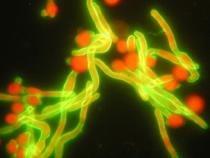Candida albicans
Candida albicans is a dimorphic fungus belonging to the Phylum Ascomycota, characterized by the presence of pseudohyphae, true hyphae, and sub-spherical blastoconidia (3–8 × 2–7 μm).
Associated with warm-blooded animals, this saprobic organism colonizes the vagina as well as the digestive and respiratory tracts in humans. It can cause infections of the skin, nails, and mucous membranes, but disseminated candidiasis, which develops mainly in immunocompromised patients, represents the most severe form of the disease.
Invasive candidiasis: a growing concern
Invasive candidiasis is a fungal disease of increasing incidence, primarily affecting immunocompromised individuals such as transplant recipients, neutropenic patients, and those living with HIV/AIDS.
It is also common in long-term hospitalized patients, individuals undergoing extensive surgery, those with indwelling catheters, and patients receiving broad-spectrum antibiotic therapy.
Clinical features
Candida is the scientific name of a yeast—a fungus commonly found in many environments, including within the human body.
Under normal conditions, the immune system keeps its growth under control. However, when the immune balance is disrupted, due to illness, antibiotic use, or other factors, Candida may proliferate and cause infection.
Candida infections can affect different parts of the body in distinct ways:
Oral thrush (oral candidiasis): fungal infection causing whitish patches in the mouth.
Esophagitis: oral thrush that extends into the esophagus, leading to painful or difficult swallowing.
Vaginal candidiasis: itching, pain, and discharge caused by Candida overgrowth.
Cutaneous candidiasis: skin infections resulting in redness, itching, and rash.
Candidemia (bloodstream infection): a severe, life-threatening manifestation.
Diagnosis
The diagnosis of invasive candidiasis remains challenging due to the absence of pathognomonic symptoms and the difficulty of isolating the fungus through blood cultures.
Conventional diagnostic methods often show low sensitivity and specificity, and some are too complex to be routinely implemented in clinical microbiology laboratories.
Treatment
Antifungal agents can eliminate Candida infections in most patients.
However, in individuals with compromised immune systems, treatment can be more complex and may require prolonged or combination antifungal therapy.


